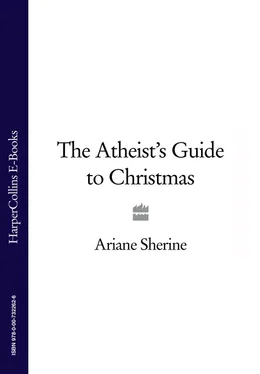Evolution, as a scientific fact, is nothing much to do with being an atheist. It has a lot to do with ruling out medieval religious dogmas as childish hangovers from an ignorant past. But the process by which the fact of evolution was realised, tested and modified has a lot to do with the revelation of knowing that there is probably no God.
And that is science’s greatest strength: as a way of knowing. It’s an unending pathway towards knowledge and enlightenment about how stuff works. It’s a thought process based on observation, experimentation, rational thinking and logic. There’s no recourse to jumping to conclusions or leaps of faith. There are dogmas in science, but they are always subject to change. When it’s wrong, it’s wrong, and we need to modify our preconceptions and develop a new and better way of tackling the problem. That’s why science is the best way of knowing how things truly are. And as such, it’s a way of thinking that should have the effect of eroding faith. So whatever the real number of egghead godheads is, the fact that there are any at all reveals not a weakness of science, nor a strength of religion, but the fallibility of people.
*This survey was entirely made up, by me, for the purposes of making a glib point.
*Precise details of this section of this conversation were unavailable at the time of going to press.
The Large Hadron Collider: A Scientific Creation Story
BRIAN COX
The Large Hadron Collider (LHC) at CERN in Geneva is the biggest and most complicated scientific experiment ever attempted. Over 10,000 scientists and engineers from eighty-five countries have built a machine that can recreate the conditions present in the universe less than a billionth of a second after the Big Bang. The reason that the world has come together at CERN in the pursuit of pure knowledge is simple: we want to understand how the world came to be the way it is. This quest has led to a remarkable description of the violence and beauty of the origin of the world, and ultimately the emergence of life and civilisation in our universe.
Around 13.7 billion years ago, something interesting happened, and our universe began. One ten million billion billion billion billionths of a second later, gravity began to separate from the other forces of nature and has remained a weak enigma ever since. After a billion billion billion billionths of a second, the universe underwent an exponential expansion, growing from less than the size of an electron to the size of a melon in one hundred thousand billion billion billionths of a second. The universe then steadied its growth, and the energy that drove the expansion was transformed into sub-atomic particles, the building blocks of everything in the universe. Around a million millionths of a second after the interesting event, something known as the Higgs field began to behave in an unusual way. This caused most of the subatomic particles to acquire mass, and there was substance in the universe for the first time. From this point onwards, we are reasonably sure that our story is correct because over the last century the LHC’s smaller cousins have explored these violent conditions in exquisite detail. We are therefore the first culture in history that is engaged in a program to test our creation story experimentally. The primary job of the LHC is to explore the story during the time when the Higgs field became influential.
The LHC is a 27-kilometre-long circular machine that accelerates sub-atomic particles called protons to as close to the speed of light as is possible with our current technology. Approximately half of your body is made up of protons; the other half is made of neutrons. The machine straddles the border between Switzerland and France, which the protons cross twenty-two thousand times every second inside two parallel drainpipe-sized tubes. Over sixteen hundred powerful electromagnets, operating at—271 degrees Celsius, keep the protons spiralling neatly around the machine in precisely controlled orbits. The tubes cross at four points around the ring, allowing up to six hundred million protons to smash into each other every second at each point. Surrounding these mini-explosions are four detectors; digital cameras sitting inside cathedral-sized caverns a hundred metres below the vineyards and farms. It is their job to photograph the stage in our creation story that we want to explore.
According to theory, the Higgs field acts like cosmic treacle. The sub-atomic particles that make up our bodies and everything we can touch in our world acquire their masses by interacting with this all-pervasive stuff. Imagine attaching a string to a ping-pong ball and pulling it through a jar of thick treacle. If you didn’t know better, you might conclude that the ping-pong ball was very massive because it feels difficult to move. This is roughly how the Higgs field works in our best theory of the sub-atomic world known as the Standard Model of particle physics. It may sound far-fetched, but the Higgs model has survived for over forty years without actually being shown to be correct because it has very elegant mathematical properties that physicists find convincing.
With the LHC, however, D-day has arrived for the Higgs model. If it is correct, then particles associated with the Higgs field known as Higgs particles must show themselves in the LHC’s underground detectors. We can be so sure because, to do the job necessary in our creation story, the Higgs particles must be light enough for the LHC to create them in its high-energy proton collisions. If the Higgs particles don’t show up, then nature must have chosen some other mechanism to generate mass in the universe, and we will observe that instead. It’s as if the LHC allows us to journey back in time to the point in our story where mass appears in the universe for the first time, and take pictures of this most important of historical events. Because we can repeat the collisions billions of times, we can carry out very high-precision measurements that will allow us to investigate our creation story scientifically.
This time in the universe’s evolution is known as the electroweak era, because two of the four forces of nature, the familiar electromagnetic force and the less familiar weak nuclear force, reveal themselves as different facets of a single unified force at these temperatures. The weak nuclear force is shielded from our everyday experience deep within the atomic nucleus, but it is vital in allowing the sun to shine because it allows protons to change into neutrons, and therefore hydrogen to fuse into helium with the release of sunlight. The LHC will probe this unification, which intimately involves the Higgs mechanism, with unprecedented precision, and verify or refute our current theoretical models.
There are also hints that there may be surprises in store. Some particle physicists believe that the Standard Model Higgs theory is flawed because it requires a very delicate fine-tuning of parameters to make it work. Fine-tuning is considered ugly in physics; if the universe only works if the strengths of the forces or the masses of particles take on very precise values then physicists naturally want to know why this should be so. Coincidences do happen, but it is wise to look for more elegant explanations. There is a popular alternative to the Standard Model that goes by the name of the Minimally Supersymmetric Standard Model, or MSSM. This theory requires a doubling of the number of fundamental particles in the universe, plus no less than five different Higgs particles.
This sounds like additional complexity rather than an elegant simplification, but the MSSM achieves more than solving some of the fine-tuning problems: it also provides a possible answer to a decades-old problem in astronomy. It has been known for some time that there is much more matter in the universe than can be accounted for by simply counting up the number of stars and galaxies that we can see. In fact, it appears that five times as much matter is required to explain the orbits of stars around galaxies and the motions of large clusters of galaxies through the universe. Models of this missing stuff, known as Dark Matter, work best if the missing matter takes the form of an as yet undiscovered heavy sub-atomic particle. Within the MSSM, such a particle does exist, and if the model is correct then this particle and a whole new zoo of its sisters should show up at the LHC. Such a discovery would represent a giant leap in our understanding of the sub-atomic world and the evolution of the universe as a whole.
Читать дальше












